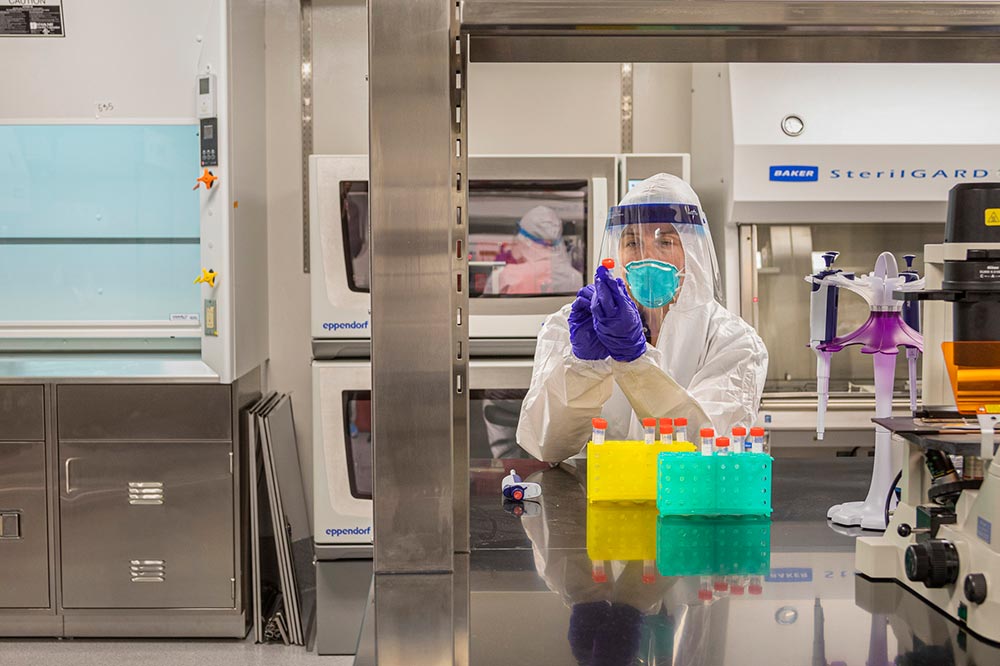Scientists Create Noninfectious Versions of SARS-CoV-2
0 View
Share this Video
- Publish Date:
- 20 October, 2021
- Category:
- Covid
- Video License
- Standard License
- Imported From:
- Youtube
Tags

With replicons, SARS-CoV-2 research need not be limited to highly biosafety labs. Credit: Frank Veronsky/The Rockefeller University
To study a virus as contagious as SARS-CoV-2, researchers must follow arduous protocols and have access to highly biosafety labs. To make such studies safer, faster and more accessible to more teams around the world, virologists have created SARS-CoV-2 replicons: self-replicating RNAs that are not contagious but are otherwise identical to the real virus.
Replicons mimic almost every aspect of the viral life cycle. Their RNA has all the information the virus needs to replicate itself and make copies of itself, but lacks instructions for making spikes, the proteins that allow the virus to enter and infect human cells. Once introduced into cells in a dish, a replicon makes progeny that cannot spread to adjacent cells.
“With this system, scientists can investigate SARS-CoV-2 and its variants, test drugs against it and evaluate neutralizing antibodies, all in a faster way and in lower biosafety settings,” said Nobel laureate Charles M. Rice, a Rockefeller virologist who works with Volker Thiel of the University of Bern and the Institute of Virology and Immunology led the work. The study is published in the journal Science.
Take the wheels off
Replicon systems have been instrumental in developing drugs against other viruses, including hepatitis C. Once Rice and others created hepatitis C replicons, other scientists were able to develop potent and safe drugs that could effectively cure this chronic viral infection.
Replicons are usually made by cloning viral RNA genomes into DNA fragments in the test tube that can then be used to make artificial RNA. But this method doesn’t work well for coronavirus RNA because it’s exceptionally long. So the researchers took a different approach, using a platform developed by Volker Thiel’s group that makes it possible to assemble coronavirus genomes from smaller fragments in yeast, rather than from the test tube.
Using this approach, they created a coronavirus genome that lacks the RNA segment with the instructions for the spike protein.
“If the virus was a race car, we would have made a version without wheels. It has the motor and all the parts that allow it to move, but it really has nowhere to go,” said Joseph Luna, a postdoc in the Rice lab and co-worker. first author.
However, removal of the spike protein poses a problem. Many current studies focus on this component of SARS-CoV-2 – for example, it is the main target of monoclonal antibody therapy. To make the replicons useful for research into therapies such as antibodies, the team expressed the spike protein separately next to the replicon. The results were replicon delivery particles, single-use viruses that can deliver replicons into cells. These particles can enter cells in a similar way to coronavirus particles, but are limited in infectivity to exactly one viral life cycle.
A wide range of applications
The scientists say their repeats could be used to study how the virus hijacks the cell’s own machinery and generates new copies of itself. In addition, they can make it possible to identify the human proteins without which the virus cannot reproduce. As proof of concept, the team examined the effects of TMEM41B, a human protein previously shown to be necessary for SARS-CoV-2 replication. Like the authentic coronavirus, the replicons were unable to replicate in cells lacking this protein.
The replicons can also be used to screen chemical libraries for drug compounds that can block viral replication. In other experiments, the team incubated the replicons with remdesivir, an antiviral drug known to inhibit the virus. “We found that it inhibits the replicon at the same concentrations as the actual virus,” said co-first author Inna Ricardo Lax, a postdoc in the Rice lab. “It shows that the replicon system can be a reliable alternative to SARS-CoV-2 to test different drugs.”
Reference: “One Cycle Replication and Delivery of SARS-CoV-2 Replicons” by Inna Ricardo-Lax, Joseph M. Luna, Tran Thi Nhu Thao, Jérémie Le Pen, Yingpu Yu, H.-Heinrich Hoffmann, William M. Schneider , Brandon S. Razooky, Javier Fernandez-Martinez, Fabian Schmidt, Yiska Weisblum, Bettina Salome Trüeb, Inês Berenguer Veiga, Kimberly Schmied, Nadine Ebert, Eleftherios Michailidis, Avery Peace, Francisco J. Sánchez-Rivera, Michael Scott W.Rivera P. Rout, Theodora Hatziioannou, Paul D. Bieniasz, John T. Poirier, Margaret R. MacDonald, Volker Thiel, and Charles M. Rice, Oct. 14, 2021, Science.
DOI: 10.1126/science.abj8430










